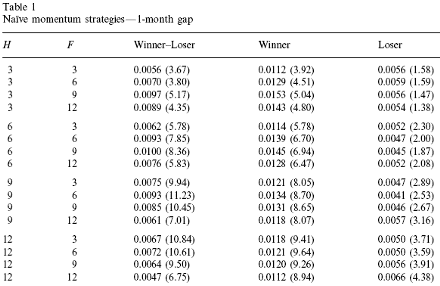The naı¨ve momentum effects
The naı¨ve momentum strategies are formed following Jegadeesh and Titman (1993). As stated in Section 1, the SEC requires all insiders to fill the Form 4 no later than the 10th of the month following their transactions, the 1-month gap can guarantee that the outsiders can receive the insiders transaction information when they form their portfolios. At the beginning of each month t, all stocks are ranked by ascending order based on their performance during the period from t−F to t, then five quintiles are formed based on the order.
The momentum strategies are formed then by short the first quintile and use the result to buy the last quintile. The zero-position is then held for H months from month t+1. Table 1 reports the profits earned by the above method. We examined the profits of the strategies in different forming and holding time horizon. In abbreviation, we call it a Forming/Holding Strategy in the following. The profits of zero-position, the profits earned by the winners and loser portfolios are listed separately in the third to fifth columns. All of these profits are on a per-month base. The results in Table 1 show that the momentum strategies can earn a positive profit in the time horizon by holding 3–12 months. The 9/6 Strategy, as an example, can earn 1% statistical significant per month profit, compared with JT’s 0.65% (no 1-month gap).
Insiders trading based momentum strategies
In this section, we examined the ability of insiders trading to predict the cross-sectional returns. The Insiders Trading Based Momentum Strategies (IBMS) is to trade by imitating the insiders trading activities. At the beginning of each month t, all the stocks’ aggregate insiders trading information in the past period is calculated and we buy what insiders bought and sold in the previous period. Table 2 reports the empirical results of insiders trading based momentum strategies using AITR method.
At the beginning of each month t, each stock’s AITR is calculated with the formula given in Eq. (1). Then, three portfolios are formed based on the AITR values. If AITR is greater than 0, we treat the stock as an insider-buy and set a dummy variable 1 with the stock. If AITR is less than 0, it is an insider-sell and a dummy variable −1 is set with the stock. Others are set with dummy variable 0, which represent there is no insider trading information with the stock, we call this kind of stock as insider-zero. We then form the zero-position with the processes:
 (2)
(2)
where Rt is the zero-position return; Rbt is the average return of insider-buyer portfolio; B is the number of stocks which are insider-buy in the forming period; Rst is the average return of insider-sell portfolio; S is the number of stocks which are insider-sell in the forming period. The position is then kept in the following H months from month t+1. Again, to make sure the outsiders can get the insiders trading information when we form the portfolio, a 1-month gap is used between the portfolio forming and holding period.
The third column to fifth column of Table 2 list the average profits of zero-position, insider-buy portfolio and insider-sell portfolio and their corresponding t-statistics respectively. The results show that all these insider based momentum strategies can earn statistically significant positive return. This finding is consistent with those of Seyhun (1998). The results show us that the insiders trading activities contain valuable information and can be used to predict future cross-sectional returns in USA market during the period January 1985–November 1996.

The naive momentum strategies are formed based on F months from month t−F to month t lagged returns and held for the period from month t+1 to t+H+1. There is a 1-month gap between the formation and holding period. The first two columns are values of H and F for different forming-holding strategies.
In any given month, all stocks are ranked in ascending order by their returns in past F months, then five equally weighted portfolios are formed based on the order. The first quintile contains stocks that have lowest returns in past F months and the fifth quintile contains those have highest returns in past F months. In each month, we buy the fifth quintile portfolio, which we call the winner, and short the first quintile, which we call a loser. The numbers in the parentheses are t-statistics. The zero-cost position is then hold for the period from month t+1 to t+H+1. The sample period is from January 1985 to November 1996.

An insiders trading based momentum strategy is formed by the following process: At the beginning of a given month t, we long insider-buy stocks and short the insider-sell stocks during past F months from month t−F to month t. The position is held then for H month from t+1 to t+H+1. An insider-buy is defined as the stock whose aggregate insiders trading ratio is greater than 0. An insider-sell is defined as the stock whose aggregate insiders trading ratio is less than 0.
The aggregate insiders trading ratio is the ratio of the net dollar value of insiders trading (dollar value of aggregate insiders purchasing-dollar value of aggregate insiders selling) in past F months and the total dollar value of insiders trading (dollar value of aggregate insiders purchasing+dollar value of aggregate insiders selling) in past F months. All the results are reported on a per month base. The t-statistics are reported in parentheses.
Jihong Xiang, Jia He , Min Cao
Next: Insider trading refined momentum strategies
Summary: Index